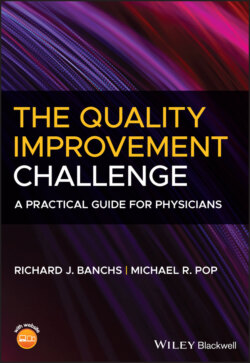Читать книгу The Quality Improvement Challenge - Richard J. Banchs - Страница 10
Why This Book?
ОглавлениеEfforts to improve the quality of healthcare have focused on increasing accountability, measurements, and new payment models. These and other efforts have failed to achieve a meaningful and sustainable improvement. Patients continue to experience fragmented, impersonal, inconvenient, and unsafe care while providers are increasingly becoming burned out by a system overburdened with administrative tasks. The current approach seems at odds with the mission of providing high‐quality care. A fundamental change is needed in how we deliver care, and how we go about improving it.
It is widely accepted that physician leadership is an essential requirement for successful quality improvement efforts. Yet physicians have been reluctant to engage, either because of the constraints of their overbooked clinical schedules, their perception of QI, or because quality priorities are often set by outsiders rather than chosen by physicians based on their insights, experience, and expertise. As a result, physicians have been marginally involved in operational improvement, and for the most part, have relinquished that responsibility to managers and hospital administrators. A strategy for improving healthcare delivery that continues to ignore the engagement of physicians is doomed to fail. Physicians should lead improvement efforts: they are well positioned to accept the improvement challenge. They have valuable insights into processes, have been trained as problem‐solvers, and making things better speaks to their intrinsic motivation. Their engagement is critical, will serve their patients well, and may be the new role physicians need to gain a sense of purpose, restore their identity, and decrease burnout.
This new role is going to require knowledge and skills that graduate and postgraduate education has not provided. To date, medical education has focused almost exclusively on the acquisition of scientific knowledge and clinical facts. This book has been written to fill this knowledge gap. Principles and practices of improvement methodology, team dynamics, and organizational change management are presented in a straightforward and clear way for any physician, young or seasoned, seeking a template for an improvement initiative. The material in this book synthesizes current knowledge on the subject from multiple authoritative sources and combines disciplines as diverse as Lean, Six Sigma, Human‐Centered Design, and Neurosciences for organizational change. The goal is to provide the reader with an integrated and systematic approach to quality improvement projects and a roadmap to address the unique, change‐resistant features associated with the healthcare environment. It is our hope that physicians everywhere will embark on an improvement journey, for the benefit of their patients, organizations, and themselves.
Richard J. Banchs, MD
Michael R. Pop, SSMBB, MBA
